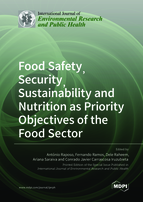Food Safety, Security, Sustainability and Nutrition as Priority Objectives of the Food Sector
A special issue of International Journal of Environmental Research and Public Health (ISSN 1660-4601). This special issue belongs to the section "Global Health".
Deadline for manuscript submissions: closed (31 March 2021) | Viewed by 143722
Special Issue Editors
Interests: food safety; food security; food innovation; natural food products; nutrition; public health
Special Issues, Collections and Topics in MDPI journals
2. REQUIMTE/LAQV, R. D. Manuel II, Apartado 55142, Oporto, Portugal
Interests: food analysis; food security; food safety; development and validation of analytical methods; bioactive compounds; foods of marine origin; aquaculture; one health
Special Issues, Collections and Topics in MDPI journals
Interests: food science; food microbiology; sustainability; Arctic; food packaging
Special Issues, Collections and Topics in MDPI journals
Interests: pseudomonas fluorescens in cheese; cleaning and disinfection in the food industry; biofilm; cheese making
Special Issues, Collections and Topics in MDPI journals
Interests: food safety; nutrition; food security; food sustainability; food science and technology; food innovation; bromatology
Special Issues, Collections and Topics in MDPI journals
Special Issue Information
Dear Colleagues,
On behalf of the International Journal of Environmental Research and Public Health, we are organizing a Special Issue about food safety, security, sustainability, and nutrition as priority objectives of the food sector. The International Journal of Environmental Research and Public Health is a peer-reviewed scientific journal that publishes manuscripts in the interdisciplinary area of environmental health sciences and public health.
Food systems are at the center of global environmental, social, and economic challenges such as resource scarcity, ecosystem degradation, and climate change. The current food systems are generating negative outcomes, such as land, water, and ecosystem degradation, biodiversity loss, excessive greenhouse gas emissions, persistent malnutrition and hunger, and are failing to eradicate poverty, particularly of rural populations in the global South. The future food systems will have to provide food and nutrition security while facing unprecedented sustainability challenges: this underlines the need for a transition to more sustainable food systems. Taking into account these premisses and considering the complexity of food systems, this Special Issue aims to present original research articles, reviews, and short communications concerning the following:
- Advancements in food and beverage
- Dietary supplements, nutraceuticals, and functional food
- Food allergy and public health
- Food and nutritional toxicology
- Food biotechnology and food processing
- Food microbiology and food safety
- Food packaging
- Food safety and food inspection
- Food security and environmental impacts
- Food waste management
- Nutrition and metabolism
- Sustainable food systems and agro-ecological food production
Dr. António Raposo
Dr. Fernando Ramos
Dr. Dele Raheem
Dr. Conrado Javier Carrascosa Iruzubieta
Dr. Ariana Saraiva
Guest Editors
Manuscript Submission Information
Manuscripts should be submitted online at www.mdpi.com by registering and logging in to this website. Once you are registered, click here to go to the submission form. Manuscripts can be submitted until the deadline. All submissions that pass pre-check are peer-reviewed. Accepted papers will be published continuously in the journal (as soon as accepted) and will be listed together on the special issue website. Research articles, review articles as well as short communications are invited. For planned papers, a title and short abstract (about 100 words) can be sent to the Editorial Office for announcement on this website.
Submitted manuscripts should not have been published previously, nor be under consideration for publication elsewhere (except conference proceedings papers). All manuscripts are thoroughly refereed through a single-blind peer-review process. A guide for authors and other relevant information for submission of manuscripts is available on the Instructions for Authors page. International Journal of Environmental Research and Public Health is an international peer-reviewed open access monthly journal published by MDPI.
Please visit the Instructions for Authors page before submitting a manuscript. The Article Processing Charge (APC) for publication in this open access journal is 2500 CHF (Swiss Francs). Submitted papers should be well formatted and use good English. Authors may use MDPI's English editing service prior to publication or during author revisions.
Keywords
- environmental health
- food safety
- food security
- nutrition
- sustainability










